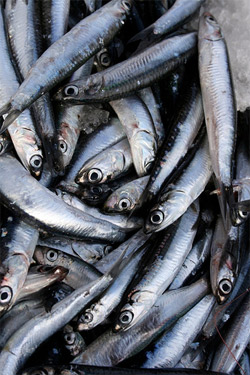Vegetarians have grown to relish — or at least tolerate — fake chicken,
mock turkey, soy hot dogs, and flame-grilled tofu burgers. But the
noble tradition of fake foods dates back to antiquity. Roman cooks
loved to disguise the flavors of their dishes. The ancients relished
food games at their banquets, and cooks took great pride in concealing
flavors so that one type of meat might taste like another — or like
nothing at all. One of the more peculiar recipes that survives from the
first extant cookbook, dating to the fourth century A.D., is called,
bluntly enough, Anchovy Casserole Without the Anchovies. The
author, Apicius, proudly boasted, “No one at the table will know what
he is eating.” Artists were employed at banquets to make realistic
sculptures of lions out of chicken meat, bulls of fish flesh, camels of
venison — anything to tickle the jaded diners.
In the Renaissance, chefs adopted the ancient fantasy theme for Fridays and Lent, when the Church strictly forbade the faithful to devour meat, eggs, or dairy. In aristocratic kitchens, inventive cooks came up with peculiar recipes for “Imitation Ricotta” and “Imitation Butter,” both made from ground almonds. Lenten “Imitation Eggs” involved more elaborate preparation: The egg whites were made from whipped fish broth, while the yolks were made from boiled rice padded into balls and dyed with saffron. As may be guessed, the goal was to recreate the appearance of forbidden foods; how they actually tasted was immaterial.
By the early 1800s, European maestros kept up the emphasis on appearance, and became far more ambitious in transforming food into art. In 1820, the Parisian celebrity chef Carême became famous for his enormous and spectacular edible table settings. He created whole mythical landscapes, with Greek temples and gardens made of spun candy and almond paste, and the winged god Cupid frozen on a swing. There were turreted medieval castles with jam moats; detailed galleons made of hazelnuts. The chef even published architectural drawings based on his meals.
But no history of edible art should leave out a grand event in 1976, when the feisty New York’s Second Avenue Deli owner Abe Lebewohl donated 350 pounds of chopped liver for an artists’ show in Soho. Fascinated Manhattanites crowded the gallery to admire a chopped liver Barbara Streisand and a 6’5” version of the World Trade Center towers straddled by King Kong. Tragically, the art was never even devoured. By the second day of the show, it was deemed “ripe” for destruction. • 14 September 2009




